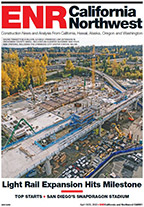At last year's high-stakes interview for a lead architect to shape a $1.2-billion retractable-roof stadium for the National Football League's Atlanta Falcons, 360 Architecture's Bill Johnson staged quite a show. Figuring correctly that his firm's comparative inexperience and lack of local connections put it at the bottom of the short list for the 1.8-million-sq-ft New Atlanta Stadium, he decided to do something "over the top" to win the work.
"We were the dark horse. Our best chance was to challenge the status quo," says Johnson, a senior principal with the Kansas City, Mo.-based 360, formed in a 2004 merger of CDFM and Heinlein Schrock Stearns.
Johnson threw caution to the wind for the winner-take-all interview. During a 90-minute pitch on April 16, 2013, he and his team presented a "convertible" stadium with a radical new design approach; they also broke with tradition by brazenly engaging the selection panel in their presentation. The audience participation and stagecraft were somewhat out of character for Johnson, a rather understated Midwesterner.
First, 360 handed out props to the audience, which included Arthur Blank, Atlanta Falcons owner, and Rich McKay, Falcons president and CEO. There were decks of "what if" cards and small, transformable toys, each with a what-if label: "What if you could create a game-day experience that pulled fans away from the comfort of home? What if the scoreboards provided views of the game seen only at the stadium? What if there was a camera embedded in the tips of a football? What if select seats shook during a hard hit?"
"All of us have some form of attention-deficit disorder, and when we got bored, we started reading the cards," says McKay. People laughed, he adds, when they came upon a wild card tucked into the 20-question deck. It asked, "What if you just hired us right now?"
That almost happened. By the end of the evening, 360 had jumped from fifth to first place, beating out EwingCole, HKS, Populous and TVS Design. Johnson got the good news the next day.
McKay explains, "The ball gimmick and the cards were all tied into [a bigger message] that we have to look at this stadium differently. That struck home."
The Falcons were especially impressed with 360's first interview slide: "Permission to Challenge Everything, Act Responsibly, Experts Outside the Industry, Embrace Change, Re-imagine the Game Day Experience, Reject Current Thinking."
"We've kept that as our go-back-to slide every time we have to make a decision on the project," says McKay. It even inspired the development's marketing slogans: "Re-imagine the Stadium Experience and Reject Current Thinking."
Blank had made it clear he wanted an architectural icon for Atlanta. Johnson, tired of a seating bowl in a box with a lid—one of which he had designed in the mid-1990s, while at Ellerbe Becket, for the Arizona Diamondbacks—jumped at the chance to introduce something fresh. "We are building the idea we brought to the interview," he says.
Johnson generated his description-defying design, which includes folded profiles and edgy shapes, by starting with the roof. At the interview, the 360 team, which also includes structural engineer Buro Happold Consulting Engineers PC, kinetic architecture consultant Hoberman Associates and mechanical-electrical-plumbing engineer WSP, unveiled a scale model with a motorized roof. "To get it done in time, we had five different 3D printers all over the country going all at once," says Erleen Hatfield, a BH principal.
Breaking interview convention, Johnson invited the audience to gather around the model. Chuck Hoberman, also the inventor of the transformable-toy handouts, then invited the Falcons' Blank to press the start button. The Falcons' McKay says the 360 team's jitters were palpable until the roof opened successfully.
Laying Foundations
Crews are just starting foundations at a state-owned site that abuts the 22-year-old Georgia Dome stadium, which will be razed after the new building opens. The new multipurpose venue, with 71,000 permanent seats, is set for completion by mid-2017.
The state-owned development is a public-private partnership, which includes $200 million from city bonds to be repaid by an existing hotel-motel tax. The Falcons Stadium Co., which holds design and construction contracts, will pay rent to the state.
The Falcons are getting an open-air stadium that can be climatized. When the roof is open, "we can turn off the air-conditioning," thanks to more than 30,000 sq ft of louvered panels and operable windows working with the 105,000-sq-ft roof opening, says Adam T. Kyle, a WSP senior associate. The roof likely will be open when the temperature is 45°F to 75°F. During cool nights, the opening will be used to precool the building. On hot days, the roof will stay closed to minimize heat gain. If rain threatens, the roof can stay open because the artificial-turf field has a drainage system.










Post a comment to this article
Report Abusive Comment